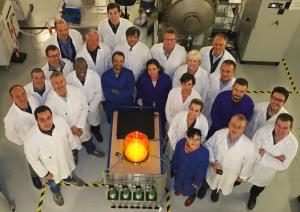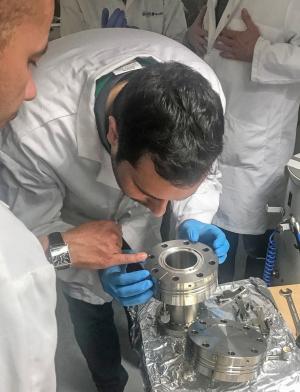Conceptualized by the ITER Organization and developed by Doosan Babcock in Scotland, the working prototype of the articulated tool can propel itself inside pipes no larger than 40 millimetres in diameter, move forward and backward, take a 90-degree turn and, thanks to a tiny video camera and built-in lighting system, provide high-resolution images (better than 0.01 mm) of potential cracks or faulty welds. The device, which is evocative of an ultraminiaturized freight train or an oversized, segmented tapeworm, is equipped with inflatable "bladders" that can isolate and locate leaks in precise sections.
Although basic in-pipe inspection tools are standard in industry for much larger pipes, the articulated tool is unique. "Nothing in the world can do what it does," says Liam. "It's reduced size means, for instance, that 100 percent of the thermal shield manifolds² are accessible for inspection and leak localization."
"With the exception of the drive mechanism, all the prototype tool's components, including motors, are off-the-shelf or slightly modified off-the-shelf," says Liam. "The concept design has been demonstrated but the tool can be significantly improved with the use of bespoke components that are smaller and lighter."
"In the more distant future, with advances in material and electronic technologies, such a tool could be further miniaturized by a factor of 10 and provide an even more powerful tool for leak localization and repair for fusion devices and many others," concludes Pearce.
Achieving and maintaining the required vacuum in the ITER machine is an immense task that the Vacuum Team took on more than one decade ago. As ITER is now gearing up for assembly operations, the team is moving forward with a new set of tools and technologies that potentially enable the localization and detection of leaks smaller than the width of hair divided by one million.
¹-Aristotle couldn't have known that at the atomic scale, Nature—that is, the material world—is essentially made of ... vacuum.
²-A manifold is an arrangement of interconnected pipes. In the ITER thermal shield, the manifolds supply cryogens to the shield's panels.
Read a related story on the Fusion for Energy website.




